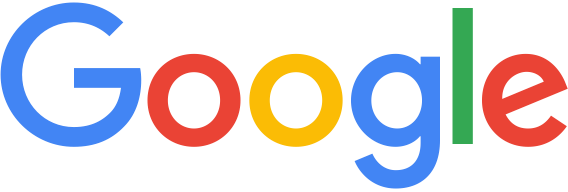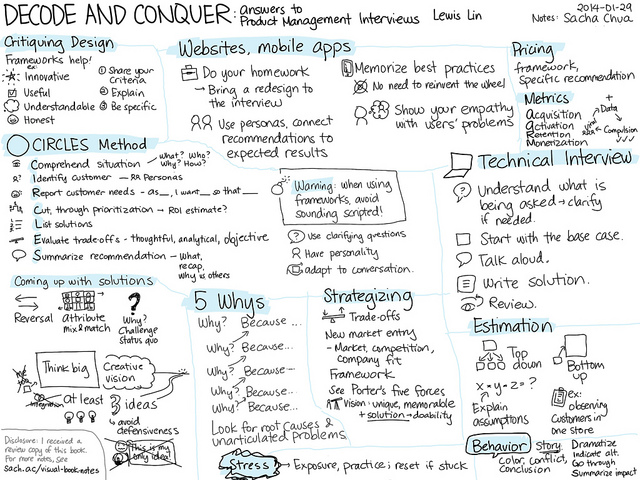
This is a self-guided, 30-day, step-by-step interview prep guide for Google product management (PM) interviews. It’s one of the most popular features from my new book, The Product Manager Interview; this brand new book has over 160 practice questions for product management interviews.
I’ve excerpted that Google PM study guide here.
Best of luck and hope the study guide helps with your product management interviews!
Lewis
30-Day Google PM Interview Study Guide
Day 1. Getting familiar with Google’s PM Interview
Tasks
Goal
Know the scope and nature of the Google PM interview.
Day 2. Getting familiar with the product design interview
Background Reading
- Read about the CIRCLES design method in Decode and Conquer.
- Review the product design examples from Decode and Conquer to see how CIRCLES is applied.
Exercises
Do the following pain point exercises in The Product Manager Interview:
- Child’s 1st Birthday Party
- Best Handyman
- Job Search Pain Points
- Finding Someone to Do Taxes
Do the following customer journey map exercises in The Product Manager Interview:
- Expedia Journey
- AirBnB Journey
- Online Course Journey
- Job Search Journey
- Home Improvement Journey
- Customer Service Journey
Goals
- Learn about product design questions.
- Understand the product design framework, CIRCLES.
- Observe how others answer interview questions with CIRCLES.
- Practice two parts of the CIRCLES framework:
- Listing (brainstorming) solutions
- Reporting customer needs (customer journey map).
Day 3. Putting product design questions together with the CIRCLES method
Exercise
Do the following product design exercises in The Product Manager Interview:
- Disney Experience with Your Phone
- Improving Google Hangouts
Goals
- Like a wine connoisseur, detect and deduce how your response differs from the sample. As you become attuned to the differences, your own responses will improve.
- For now, don’t worry about response quality or speed. Getting started, by practicing, is half the battle.
Day 4 to 10. Putting product design questions together with the CIRCLES method
Exercise
Complete one example a day for the next seven days, choosing from the list of questions from The Product Manager Interview, below.
- Improving Google Play Store
- Monetizing Google Maps
- Mobile App Design for Nest
- Favorite Product
- Favorite Website
- People You May Know
- Car for the Blind
- ATM for the Elderly
Goals
- Easily explain why CIRCLES leads to better interview responses.
- Understand when, how and why one should adapt CIRCLES.
Day 11-13. CIRCLES in Real-life
Exercise
Further improve your product design skills by applying the CIRCLES Method to real-life. For each one of the next three days:
- Walk around the neighborhood.
- As you walk, use the CIRCLES method to improve everyday items. Here are some design problems you can ponder:
- How can sidewalks be improved?
- How can street lamps be more effective?
- Build a product to solve the dog poop problem.
- What new products can prevent flat tires in cars or bikes?
- What innovation can make gardening less of a chore?
- What innovative new product can make park gatherings be more social, with strangers?
Goal
Acculturating a product design mindset 24 hours a day, both at the interview and in your everyday life.
Day 14*. Find a practice partner for product design
Exercise
Sign up for the product management interview practice group on Slack: bit.ly/PMInterviewGroup
Post a request for a partner or partners in the #req-practice-ptr channel.
Take turns during your practice session. That is, Partner A (interviewer) gives a case to Partner B (interviewee). Then, swap roles.
Coordinate in advance which case each person will receive; to simulate the interview environment, the interviewee should do a case that they are not familiar with. The interviewer should take time to acquaint themselves with the question and the sample answer.
* Repeat the partner practice activity as often as you would like. The best candidates will have practiced at least 20 product design cases.
Goal
Master the product design interview. It is the number one reason why candidates fail the Google PM interview. If you have committed yourself to thoughtful practice, you should be an expert when it comes to tackling product design questions. Use the guidelines below to gauge your product design proficiency:
- A novice suggests the obvious or copies competitive features. An expert suggests novel and memorable ideas. An expert suggests ideas that make the interviewer go, “Hmm, I wish I thought of that; maybe I should build a company based off of that idea.”
- A novice mentions user insights that are shallow. The novice does not take interest in users or their motivations. The novice is deficient in user empathy. The expert is a lifelong learner of human psychology and behavior. An expert continually asks questions about what people do and why they do it. As a result, an expert easily points out insights that are urgent, relevant and surprising.
- A novice follows the CIRCLES method step-by-step, like a home cook trying to make a sophisticated soufflé for the first time. The novice is afraid of making mistakes and clings tightly to a prescribed framework. The novice is so busy trying to recall the different steps of the CIRCLES framework that the novice’s responses sound robotic and textbook. The expert understands that a framework is a checklist, not a recipe. The expert understands that CIRCLES is there to prevent errors of omission. CIRCLES is there to help ensure that the listener’s experience is complete, satisfying and possibly even entertaining.
Day 15. Getting familiar with the metrics interview
Background Reading
- Read about the AARM framework in Decode and Conquer.
- Read metrics examples in Decode and Conquer to get familiar with metrics questions in an interview setting.
Exercises
Do the following metrics brainstorming exercises in The Product Manager Interview:
- Metrics for eCommerce
- Metrics for Two-sided marketplaces
- Metrics for SaaS
- Metrics for Mobile Apps
- Metrics for Publishers
- Metrics for User-Generated Website
- Metrics for Support Tickets
Do the following metrics prioritization exercises in The Product Manager Interview:
- Most Important Metric: Two-Sided Marketplace
- Most Important Metric: Mobile App
- Most Important Metric: eCommerce
Goal
Get more familiarity in coming up with and identifying good metrics.
Day 16. Diagnosing metrics problems
Exercises
Complete the following examples in this book, on your own or with a partner:
- Shopping Cart Conversions
- Mobile App Ratings
- Reddit Posts
Goals
Gain proficiency in brainstorming a complete and exhaustive list of issues when troubleshooting a metric.
Day 17 and 18. Putting the metrics problem together
Exercises
Complete one example a day for the next seven days, both on your own and with your practice partner, from this book.
- Your Favorite Google Product
- Drop in Hits
- Declining Users
- Slow Download on Kindle
- Pinterest Metrics
- Go-to-Market and Success
- Metrics for Uber Pick-up
Goals
Build proficiency in identifying, prioritizing and diagnosing metrics issues.
Day 19. Getting familiar with the estimation interview
Tasks
- Read about estimation questions in Interview Math.
- Read the following estimation examples in Interview Math to get familiar.
- Women’s Rain Boot Market
- Smartphone Case Market
- Subway’s Sales
- Netflix Subscription Sales
Goals
- Learn about estimation questions.
- Learn how to setup estimation questions using issue trees.
- Learn how to make assumptions.
- Try the following estimation questions:
- Cars in Seattle
- How Many Google Apps Users
- Revenue from YouTube Red
Day 20. Practice estimation questions
Tasks
Complete one example a day, from this book, for the next seven days.
- Planes in the Air
- Gmail Ads Revenue
- Google Buses
- Gmail Costs
- Driverless Car Purchases in 2020
- Storing Google Maps
- Facebook’s Ad Revenue
Goals
Master estimation questions. Not only is response quality important, but also you should complete most estimation questions in about 10 to 15 minutes.
Day 22. Learn more about strategy questions
Tasks
Read the following chapters in Decode and Conquer.
- Strategizing: Tradeoffs
- Strategizing: New Market Entry
- Strategizing: CEO-Level Issues
Goals
- Learn about common strategy question types.
- Figure out how to approach strategy questions using frameworks.
- See how the frameworks are applied to common PM strategy questions.
Day 23. Practice strategy questions
Tasks
Practice the following strategy questions, in this book, either on your own or with your practice partner:
- Google’s TV Cable Service
- iPhone Exclusive Partnership
Goals
Provide a response that is thoughtful, logical and addresses the company’s objectives. For more examples of thoughtful strategy responses, refer to the popular blog, stratechery.com.
Day 24. Learn more about pricing questions
Tasks
Read the “Pricing” chapter in The Marketing Interview.
Goals
- Learn about pricing questions, including the difference between pricing new vs. existing products.
- Figure out how to approach pricing questions using frameworks.
- See how to apply pricing frameworks to popular questions.
Day 25. Practice pricing questions
Tasks
Practice the following pricing questions, either on your own or with your practice partner:
- Pricing New Products
- Google Driverless Car Pricing
- Google and Teleportation
- Pricing Existing Products
- AWS Price Reduction
- Kindle Pricing at Target
Goals
- Google’s Strategy
- Google vs. Microsoft
- Google Moonshot Projects
- Google Maps in Mongolia
- Google Store
Day 26. Traditional and Behavioral Questions
Tasks
- Read the “Winning the Behavioral Interview” chapter in Decode and Conquer.
- Draft and polish your answers for the following questions:
- Tell me about yourself.
- Why Google?
- Influencing your team
- Practice and get feedback from your practice partner
Goals
While Google has an affinity for case questions, you should spend some time preparing for traditional and behavioral questions. Google interviewers usually ask traditional icebreaker questions like “Tell me about yourself” and “Why Google?” However, behavioral interview questions like “Tell me a time when you influenced a team” is a newer occurrence. Google’s HR department, since 2013, has asked its PM interviewers to ask more behavioral interview questions.
Day 27. Getting Familiar with Technical Interview Questions
Tasks
Review the technical topics suggested in: bit.ly/PMPrepPlan
Goals
Gain familiarity with technical concepts and questions. At Google, technical interview questions are reserved for on-site interviews, usually for candidates who have succeeded in other parts of the interview such as product design, analytics and strategy questions.
Day 28. First Try at Technical Interview Questions
Tasks
Attempt the following technical interview questions:
- 100-Story Building and Two Eggs
- Reducing Bandwidth Consumption
a
Goals
Try some technical interview questions, with a focus on calming your nerves and approaching questions with open curiosity. The “100-Story Building and Two Eggs” question is an example of an algorithm question. “Reducing Bandwidth Consumption” is an example of a technical architecture question.
Day 29-30*. Second Try at Technical Interview Questions
Tasks
Attempt the following technical interview questions from The Product Manager Interview:
- Load Balancer for Google.com
- Dictionary for Scrabble
- Google Search Services
- Bayesian vs. AI
* Repeat the technical interview practice activity, as necessary.
Goals
Build confidence tackling technical interview questions.
—
Photo Credit: Google Inc



